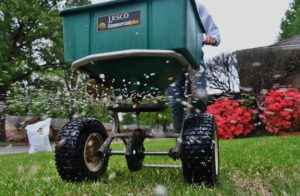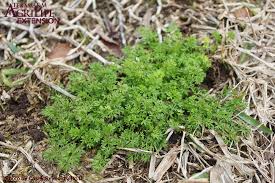As soil temperatures cool, now is the time to plan for preemergence herbicide applications to eradicate common cool-season weeds like annual bluegrass and lawn burweed, said a Texas A&M AgriLife Extension Service expert.

Applicating preemergence herbicides can reduce broadleaf and grass weeds in spring. (Texas A&M AgriLife Extension photo by Adam Russell)
Chrissie Segars, Ph.D., AgriLife Extension turfgrass specialist, Dallas, said homeowners looking to improve the look and feel of their lawns by preventing annual weeds and burs should prepare to apply fall preemergence herbicides. Preemergence herbicides are designed to disrupt the germination and emergence of unfavorable plants.
Other fall and winter management practices like proper irrigation will also ensure turfgrass emerges healthy in the spring.
“Fall weed management is an important part of annual turfgrass maintenance,” she said. “It rids lawns of undesirable plants that compete with our turfgrass and helps your lawn get a good start in the spring.”
Ridding lawns of weeds
Preemergence herbicide treatments in the fall can help rid your lawn of grassy weeds like annual bluegrass and rescuegrass, and broadleaf weeds like henbit, chickweed, Carolina geranium and lawn burweed. Choosing the right herbicide can seem daunting, but AgriLife Extension has a number of publications dedicated to identifying weeds and herbicide selection.
Segars said preemergence active ingredients are an important consideration for tackling unwanted weeds. Products will typically list a range of plants it will control whether perennial or annual and broadleaf plants or grasses. Preemergence herbicides are most effective on annual weeds, while other weeds must be controlled with post-emergence applications.

Lawn burweed is a common broadleaf weed that grows low to the ground in the spring. They typically go unnoticed until the tiny stickers are stepped on. Fall preemergence herbicides can rid lawns of the painful and pesky weed. (Texas A&M AgriLife photo)
“Having knowledge of seasonal, chronic weed problems will help you narrow down product choices,” she said. “Choosing the right active ingredient for your problem weeds and applying it correctly are very important to weed management.”
Segars said homeowners who are not comfortable handling or applying chemical products should contact local landscape professionals. You should always follow product labels and distance applications from desirable plants to avoid injuring them.
Preemergence herbicide applications
Segars said AgriLife Extension recommends the fall preemergence herbicide regimen to begin when soil temperatures reach approximately 70 degrees. This recommendation is commonly based on annual bluegrass – a weed that germinates when soil temperatures are below 70 degrees. This generally falls in September or October, depending on where you are in Texas.
“Don’t get into the habit of relying on the same calendar date every year; that’s why we have soil temperature recommendations,” she said. “Environmental conditions can be drastically different from year to year. Some weeds will germinate later in the season but applying products in a timely manner builds up a preemergence program that stays ahead of weeds.”
Segars said soil temperature probes, even probe-type meat thermometers, can help homeowners gauge application timing.
There are weather-related websites and applications that monitor soil temperatures and even give updates via notifications, she said.
Identifying which weeds you want to control is important for choosing the correct herbicide option, such as broadleaves and grasses or perennial and annual weeds, she said. Segars recommends granular herbicides for homeowners due to ease of application.
“For best results, we generally recommend at least one application of a preemergence herbicide in the spring and fall,” she said. “These two applications, if done properly, can greatly reduce the number of annual weeds in your yard.”
Segars said some homeowners may desire to make a second or split application of preemergence, and it’s a good idea to have both a pre- and post-emergence herbicide on hand for the second application.
“Herbicides aren’t 100% effective every time, especially if you have heavy rains following application or missed the desirable timing,” she said. “Having a mixture of a pre- and post-emergence product just ensures you catch any weeds that break through your original application while they are immature.”
Watering in the preemergence herbicide immediately after application using some type of sprinkler system is recommended. Typically, granular preemergence products need one-quarter to one-half inch of water to dissolve properly, but always follow product label instructions, she advised.
“It’s easy to water in the product, especially if you have an in-ground irrigation system,” she said. “It could be risky trying to time it with rainfall. So, I would recommend using a sprinkler and figuring out how much water it is putting out and how long you’ll need to water to correctly activate the herbicide.”
AgriLife Extension has information regarding irrigation and sprinkler audits that will help homeowners determine how long to irrigate specific amounts. For more information about irrigation, visit the Texas A&M Extension School of Irrigation.
Say ‘no’ to weed and feed in the fall
Weed and feeds are a common and popular product, but Segars does not recommend using them as a fall/winter turfgrass management tool.
“We’re entering a time when warm-season grasses are slowing down in a lot of the state, and we don’t want to fertilize them too late, especially with nitrogen,” she said. “Putting nitrogen down promotes growth, and a quick freeze could cause damage.”
Segars said the last nitrogen application should be no later than four to six weeks before the average date of the first frost.
Watering as seasons change
Turfgrass needs adequate soil moisture going into winter, but as temperatures fall, Segars said homeowners should dial back on irrigation. AgriLife Extension’s Water-Wise Checklist provides good year-round recommendations that will maximize irrigation efficiency and effectiveness.
Approximately 1 inch of water per week is AgriLife Extension’s summer turfgrass irrigation recommendation for actively growing grass. But as fall nears, Segars said rains should be enough, and that allowing grasses to visibly wilt before supplemental water applications is a good rule of thumb.
“If we are receiving typical fall rains, you can turn the system off or just water as needed until the grass goes dormant,” she said. “You don’t want to overwater, but you also want to have some moisture in the soil, especially in areas that experience hard freezes. Having some moisture in the ground will help protect them from winterkill and sustain them through winter.”
Scout now for spring preemergence application
Segars said now is a good time to scout for summer weeds like crabgrass and sandburs. Sandburs are a warm-season perennial grass known for their spiked seed pods that grow at the end of the stem and drop or attach themselves to any human or animal passersby.
Spring preemergence applications typically start when soil temperatures reach around 50-55 degrees, which can be January to March based on location and weather conditions.
“Make note of what weeds you have now, and prepare for spring preemergence application,” she said. “Identify the weeds you have and note where they are. Make a game plan for getting your warm-season grasses off to a good start in the spring.”
Written by: Adam Russell, AgriLife Communication Specialist

 .
.